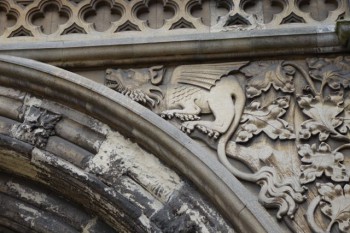In Pursuit Of the Dragons Of Britain

As some few of you may know, I recently abandoned my luxurious offices in Black Gate’s sprawling Indiana Compound and have set my course by a wandering star. My prime objective (if not my Prime Directive) is to find a real, live dragon.
So far, no go. On the plus side, I have found definite signs of dragons in all quarters of my British hunting grounds. In fact, if carvings and statuary are any guide, dragons remain downright popular and have been so for centuries. Surely their real life counterparts cannot be far afield? Lurking just over the next moor, I should think, spitting flame and devouring maidens.
The most remarkable thing about dragons is how they induce credulity. Dragon fans become, with time, less like a fine aged wine and instead rather like my old friend Fox Mulder: against all reason, we want to believe. Maybe firedrakes and so on don’t exist –– maybe I’m off on a wild goose chase, and I should scarper back to the Indiana Compound forthwith –– but having grown up on Smaug, Quok, and the Reluctant Dragon, I find that I run along on fumes of faith. Dragons are simply too magical to track them with anything less than full-bore belief.

What is it about dragons that causes such life-long romances? It can’t be their size. If historical representations are any guide, adult dragons don’t grow much larger than a wolf. Most don’t seem to be capable of flight; their wings are minuscule. What flames they spout seem not to stretch much past their jaws. All in all, these are not the vaunted beasts of destruction foisted on readers by 20th century authors from Tolkien to Martin.
Next question: What exactly was it about dragons that inspired authors of the last century or so to effectively Supersize this otherwise manageable if not entirely innocuous beastie?
The English term “dragon” derives from an ancient Greek word that is most often transliterated as drákōn, meaning “serpent of huge size, water-snake.” (Source: Liddell and Scott, A Greek-English Lexicon, by way of the Perseus project.) Note the lack of wings or Vesuvian capabilities. It’s just a big snake.
Indeed, in the European tradition, dragons remained quite serpentine (although some depictions show wings) until well into the Middle Ages. The Medieval period began the dragon’s slow march toward lethal role-playing opponent. Dragons grew legs, typically four, sometimes only two (wyverns), and soon the flames belched forth. Beowulf had to contend with four legs, flames, and poison, if memory serves. St. George was lucky not to have his steed’s hooves burnt off. A few of the more ambitious dragons grew extra necks and heads.

In carvings, tapestries, woodcuts, paintings, mosaics, and sketches, dragons have proven to be so numerous that it really is a wonder I haven’t yet bumped into one. After all, I must presume that at least one of the many artists whose work I’ve encountered was able to draw, sculpt, or otherwise work “from life.” How they got the dragon to sit still, I’ve no idea, but surely they had a model (like Pickman) from which to work. The law of averages requires it!
So I soldier on, peering into dank corners, lurking around caves and church yards, hoping against hope that one or more lonely members of the species live on.
I mean, A Dance With Dragons can’t be all made up.
Can it?
What follows is a selection of the Evidence So Far. Proof positive that dragons exist, at least in some form. Various forms, even. And that this here Albion Isle is positively crawling with them.
Let me know your favorites, eh?
Onward.







